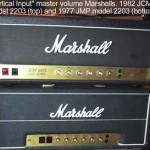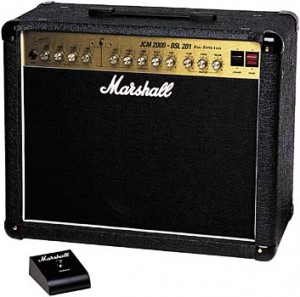 We love our Marshall amps! The purpose of this article is to recognize the various changes in the amplifiers from the “metal panel” era of the JMPs from to the JCM 2000 series so that the potential buyer can be better educated. Some deliver the goods better than others and I’ve owned many Marshall amps over the years and had to learn the hard way after plenty of dollars spent. Ultimately though — use your own ears and compare. Enjoy the next installment of our Marshall Shopper’s Guide.
We love our Marshall amps! The purpose of this article is to recognize the various changes in the amplifiers from the “metal panel” era of the JMPs from to the JCM 2000 series so that the potential buyer can be better educated. Some deliver the goods better than others and I’ve owned many Marshall amps over the years and had to learn the hard way after plenty of dollars spent. Ultimately though — use your own ears and compare. Enjoy the next installment of our Marshall Shopper’s Guide.
Read More »
Tag Archives: marshall
The Marshall Shopper’s Guide Part 1: Marshall Plexi Era
One of the most common questions we get here is, “What kind of Marshall amp should I buy?” We get countless questions not only about what type to get, but also questions about specific vintage vs. newer models, higher powered vs. lower powered models, types of speakers and how do they all sound, etc.
Read More »
THD Electronics Hot Plate Attenuator
It’s not a secret that nothing beats the sound of a great guitar tube amp cranked up. When a tube amp is driven to overdrive, rich and musical even-ordered harmonics flow in abundance and the amplifier seems to take on a new sense of dynamic character that responds better to a player’s touch. It is this feel that gives a tube amp an organic and natural sense, while solid-state amplifiers are considered more sterile in sound because of the lack of this response or harmonics.
The age-old problem has been getting the great tube amp sound at lower and more realistic levels. As the majority of musicians play relatively small clubs and in even smaller practice rooms, only the minority (i.e. those famous guitarists!) get the real opportunity to play these tube amps at the volumes that they sound best. As a result, many of our classic and much beloved Marshall, Fender, and Vox amplifiers are often seen used with distortion and fuzz boxes to compensate. While my personal belief is that these distortion and fuzz boxes are useful in some applications, they are certainly not the best way to achieve great tone when used strictly as the sole source of distortion.
Read More »
Interview with Marshall VP Mitch Colby on Marshall HW Series
 Recently at the past 2004 NAMM show, Marshall formally unveiled its latest line of amplifiers – vintage recreations called the Hand Wired series. For many vintage amp tone enthusiasts (myself included), this was just the move that we had hoped Marshall would someday make.
Recently at the past 2004 NAMM show, Marshall formally unveiled its latest line of amplifiers – vintage recreations called the Hand Wired series. For many vintage amp tone enthusiasts (myself included), this was just the move that we had hoped Marshall would someday make.
Read More »
Marshall’s All-Tube 20 Watt Combo – JCM 2000 DSL-201
Throughout its history spanning nearly 40 years, Marshall has continued to produce amplifiers that have been successfully adopted and used by musicians worldwide. As the years progressed, Marshall amplifiers came offered with a variety of additional features to suit the needs and requests of musicians through changing times. Nowadays, a fully equipped Marshall incorporates two or three channels, reverb, an effects loop, speaker-emulated direct outs, additional preamp stage gain, as well as a wide array of independent tones and volume controls for each available channel.
 Power requirements have changed as well. With today’s modern p.a. systems being more than suitable to run the entire band, it is no longer required to run a Marshall stack at full volume and save the p.a. system “just for the vocals”. Today’s guitarists playing club gigs will often mike up through house sound, hence the increased popularity of guitar amplifiers that incorporate their gain within the preamp stage instead of getting distortion by overloading the power tubes. There are benefits and drawbacks to this distortion approach and it is one that truly goes beyond the scope of this article so it will not be discussed here. However, when all is said and done, musicians in general seem to appreciate the added flexibility that additional preamp gain stages provide.
Power requirements have changed as well. With today’s modern p.a. systems being more than suitable to run the entire band, it is no longer required to run a Marshall stack at full volume and save the p.a. system “just for the vocals”. Today’s guitarists playing club gigs will often mike up through house sound, hence the increased popularity of guitar amplifiers that incorporate their gain within the preamp stage instead of getting distortion by overloading the power tubes. There are benefits and drawbacks to this distortion approach and it is one that truly goes beyond the scope of this article so it will not be discussed here. However, when all is said and done, musicians in general seem to appreciate the added flexibility that additional preamp gain stages provide.
Marshall’s JCM 2000 Dual Super Lead series of amps are designed for musicians that require two independent channels of pure tube Marshall tone at a reasonable price. Models are available in a variety of wattages, from the 100 watt DSL 100 head, down to the baby of the line, the 20 watt DSL 201 combo. For those in need of three channels and wish to pay an added premium, Marshall also offers its JCM 2000 Triple Super Lead Series. For this review however, we’ve opted to take a look at Marshall’s 20 watt DSL 201 combo. As a practice amp, or as a club or gigging amp, the DSL 201 offers a wide range of tonal options.
Read More »
Exploring Edward Van Halen’s Early Legendary “Brown Sound”
Edward Van Halen’s technique, tone, and style are legendary. Growing up listening to earlier-era Van Halen, I was awestruck by the raw, pure rock sounds that Edward produced from his guitars. In a period where rock guitar had become stagnant, Edward burst onto the scene like a fireball. As we moved into the 80’s, it seemed everyone had become an Eddie-clone, with their custom hot-rodded guitars strat-styled guitars and Marshall 100 watt tops. Edward’s sound from that era has been dubbed the “brown sound”. Let’s look into how what he used in the early days of Van Halen.
Read More »